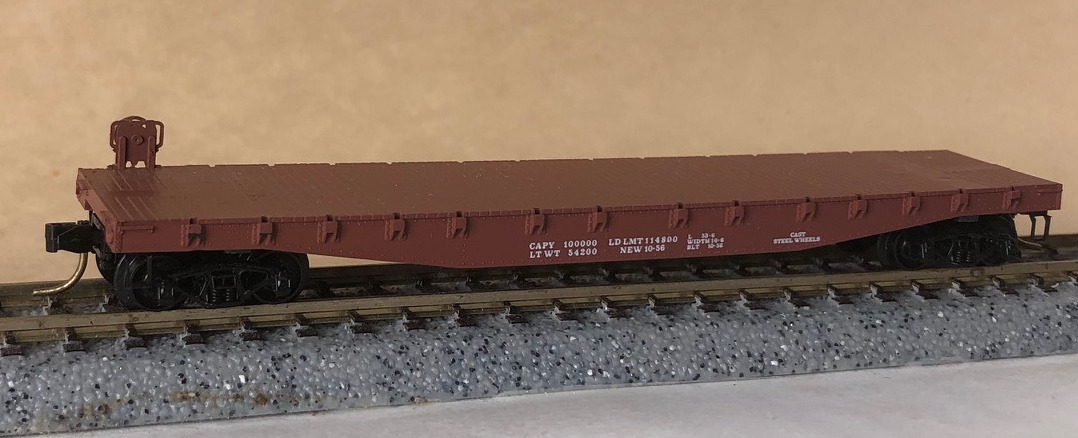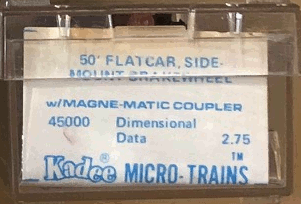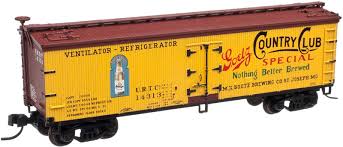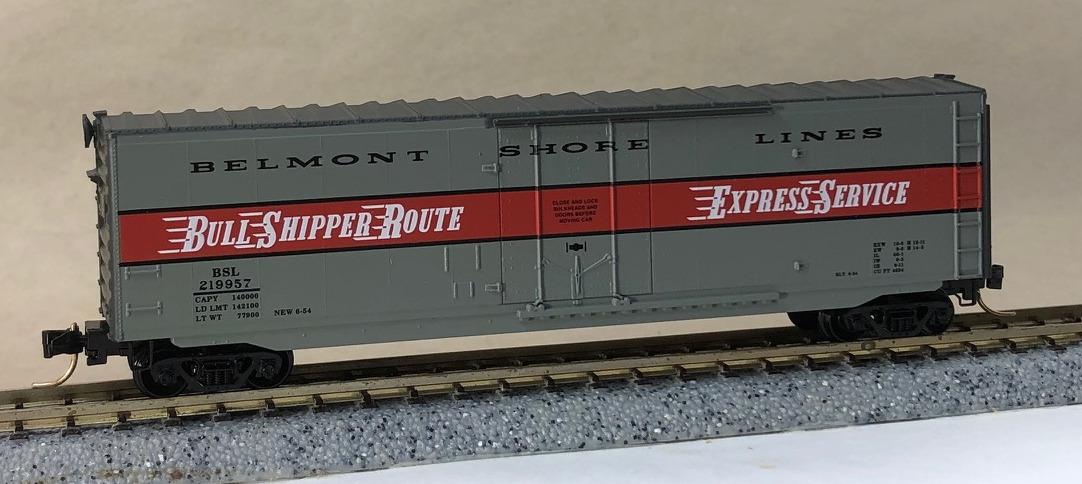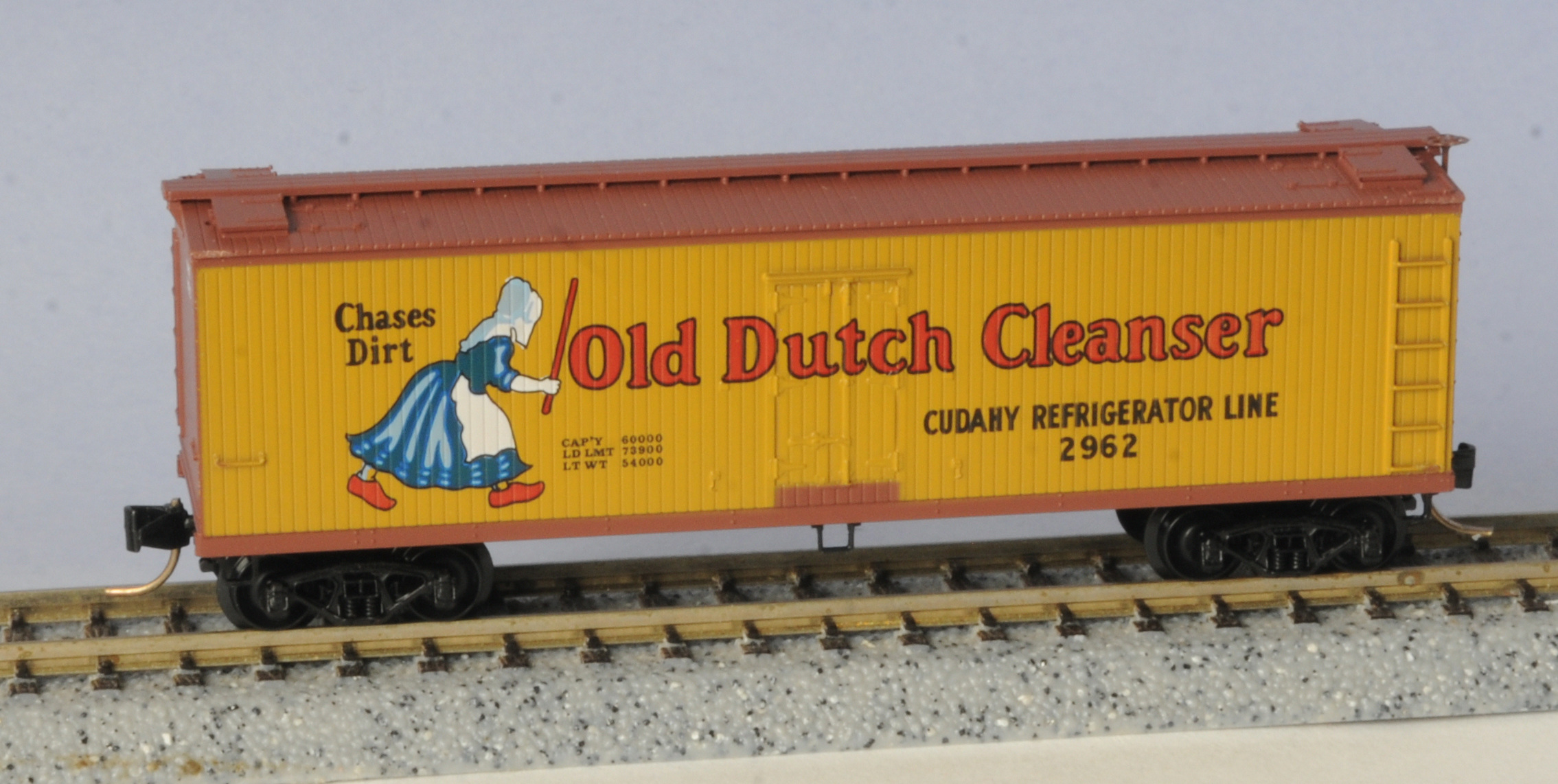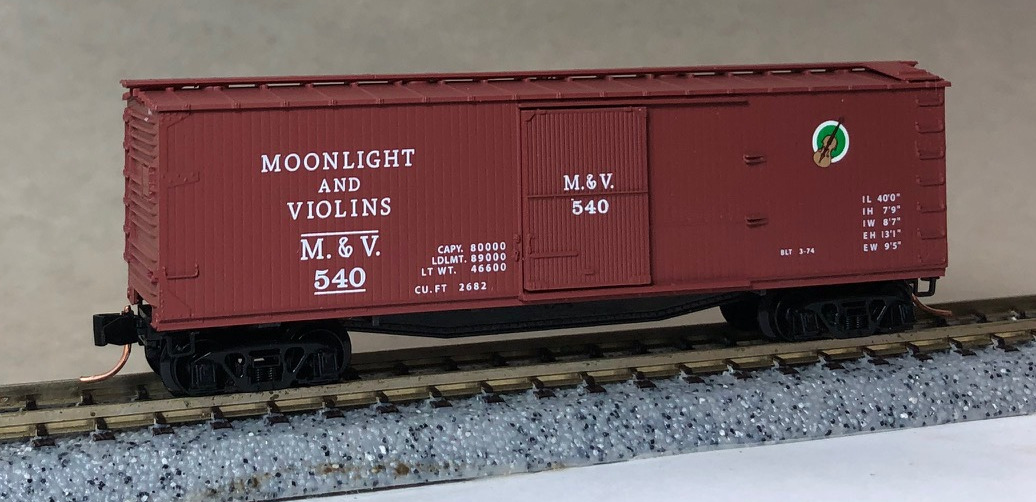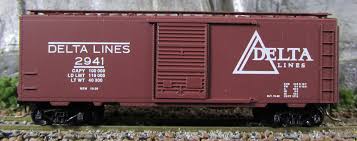Model Information: This model is Micro-Trains most popular flatcar. It models a 50 foot prototype. More than 140 different versions have appeared in Micro-Trains regular releases and many more in special runs.
Prototype History: A flatcar (US) (also flat car (US) or flat wagon (UIC)) is a piece of railroad (US) or railway (non-US) rolling stock that consists of an open, flat deck mounted on a pair of trucks (US) or bogies (UK), one at each end containing four or six wheels. Occasionally, flat cars designed to carry extra heavy or extra large loads are mounted on a pair (or rarely, more) of bogeys under each end . The deck of the car can be wood or steel, and the sides of the deck can include pockets for stakes or tie-down points to secure loads. Flatcars designed for carrying machinery have sliding chain assemblies recessed in the deck.
Flatcars are used for loads that are too large or cumbersome to load in enclosed cars such as boxcars. They are also often used to transport intermodal containers (shipping containers) or trailers as part of intermodal freight transport shipping.
From Wikipedia
Flatcars are used for loads that are too large or cumbersome to load in enclosed cars such as boxcars. They are also often used to transport intermodal containers (shipping containers) or trailers as part of intermodal freight transport shipping.
From Wikipedia
Road Name History: 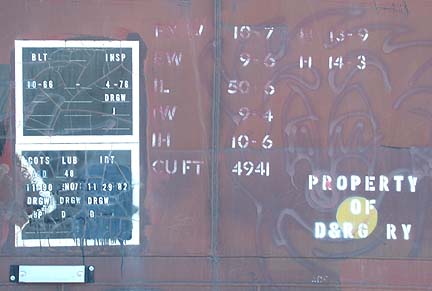 "Dimensional Data" here means painted models with printed body specifications and no road/reporting letters/marks or road Name/livery. The data typically consists of internal and external dimensions, capacities, weight information and specific characteristics of freight cars, trailers and containers.
"Dimensional Data" here means painted models with printed body specifications and no road/reporting letters/marks or road Name/livery. The data typically consists of internal and external dimensions, capacities, weight information and specific characteristics of freight cars, trailers and containers.
The Association of American Railroads (AAR) sets standards for the uniform marking of freight cars with regard to car ownership, weight, load capacity, dimensions, and maintenance. In addition, car owners choose to display data relating to various devices and equipment so the cars may be properly used and repaired.
CAPY (nominal capacity) is the intended load-carrying capacity of the car, to the nearest 1000 pounds. This is determined by the structural strength of the car's underframe and the size of the journal bearings of the car's trucks.
LD LMT (load limit) is the maximum weight of lading that can be carried by the car, to the nearest 100 pounds. This is determined by subtracting the weight of the car when empty from the total allowable gross weight given the size of the car's journal bearings. The load limit for a car is usually a bit greater than its capacity; the two figures can be equal, but capacity can never exceed load limit.
LT WT (light, or empty, weight) is the weight of the car when empty. Accompanying the light weight marking is a date indicating when the railroad or owner last verified the car's weight. The letters for this mark are not always reporting marks; sometimes a location code is used. NEW and a date indicates that the weight shown is the car's as-built weight, and that it hasn't been field-checked since.

The Association of American Railroads (AAR) sets standards for the uniform marking of freight cars with regard to car ownership, weight, load capacity, dimensions, and maintenance. In addition, car owners choose to display data relating to various devices and equipment so the cars may be properly used and repaired.
CAPY (nominal capacity) is the intended load-carrying capacity of the car, to the nearest 1000 pounds. This is determined by the structural strength of the car's underframe and the size of the journal bearings of the car's trucks.
LD LMT (load limit) is the maximum weight of lading that can be carried by the car, to the nearest 100 pounds. This is determined by subtracting the weight of the car when empty from the total allowable gross weight given the size of the car's journal bearings. The load limit for a car is usually a bit greater than its capacity; the two figures can be equal, but capacity can never exceed load limit.
LT WT (light, or empty, weight) is the weight of the car when empty. Accompanying the light weight marking is a date indicating when the railroad or owner last verified the car's weight. The letters for this mark are not always reporting marks; sometimes a location code is used. NEW and a date indicates that the weight shown is the car's as-built weight, and that it hasn't been field-checked since.
Brand/Importer Information: Micro-Trains is the brand name used by both Kadee Quality Products and Micro-Trains Line. For a history of the relationship between the brand and the two companies, please consult our Micro-Trains Collector's Guide.
Manufacturer Information:  Kadee Quality Products originally got involved in N-Scale by producing a scaled-down version of their successful HO Magne-Matic knuckle coupler system. This coupler was superior to the ubiquitous 'Rapido' style coupler due to two primary factors: superior realistic appearance and the ability to automatically uncouple when stopped over a magnet embedded in a section of track. The success of these couplers in N-Scale quickly translated to the production of trucks, wheels and in 1972 a release of ready-to-run box cars.
Kadee Quality Products originally got involved in N-Scale by producing a scaled-down version of their successful HO Magne-Matic knuckle coupler system. This coupler was superior to the ubiquitous 'Rapido' style coupler due to two primary factors: superior realistic appearance and the ability to automatically uncouple when stopped over a magnet embedded in a section of track. The success of these couplers in N-Scale quickly translated to the production of trucks, wheels and in 1972 a release of ready-to-run box cars.
In October 1990 Kadee separated in two companies, with the newly created Micro-Trains® Line Co. continuing the Z, Nn3, and N Scale product ranges, with Kadee retaining the HO range.

In October 1990 Kadee separated in two companies, with the newly created Micro-Trains® Line Co. continuing the Z, Nn3, and N Scale product ranges, with Kadee retaining the HO range.
Item created by: Lethe on 2015-05-31 17:46:30. Last edited by meadowsn1956 on 2023-05-26 20:35:51
If you see errors or missing data in this entry, please feel free to log in and edit it. Anyone with a Gmail account can log in instantly.
If you see errors or missing data in this entry, please feel free to log in and edit it. Anyone with a Gmail account can log in instantly.


